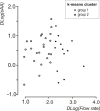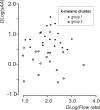Salivary alpha-amylase activity and salivary flow rate in young adults
- PMID: 23524385
- PMCID: PMC3601341
- DOI: 10.2174/1874210601307010007
Salivary alpha-amylase activity and salivary flow rate in young adults
Abstract
The secretion of salivary alpha-amylase (sAA) is more associated with psychoneuroendocrinological response to stress than with the flow rate and age. The aim of this cross sectional study is to build an explanatory model based on patterns of relationship between age 20-39 in resting and stimulated saliva under no stressful condition in healthy volunteers. Both resting and stimulated saliva were collected from 40 subjects. The sAA values were log-transformed, the normality assumption was verified with the Shapiro-Wilk test and the reliability of the measurements was estimated by the Pearsons' r correlation coefficient. The estimated model was based on the theory of the Linear Mixed Models. Significant mean changes were observed in flow rate and sAA activity between resting and stimulated saliva. The final model consists of two components, the first revealed a positive correlation between age and sAA while the second one revealed a negative correlation between the interaction of age × flow rate in its condition (resting or stimulated saliva), with sAA. Both flow rate and age influence sAA activity.
Keywords: Salivary flow rate; age.; salivary alpha-amylase.
Figures






Similar articles
-
[Effect of 3 saliva collection methods on salivary secretion].Shanghai Kou Qiang Yi Xue. 2015 Oct;24(5):563-8. Shanghai Kou Qiang Yi Xue. 2015. PMID: 26598189 Chinese.
-
[Effect of citric acid stimulation on salivary alpha-amylase, total protein, salivary flow rate and pH value in Pi deficiency children].Zhongguo Zhong Xi Yi Jie He Za Zhi. 2015 Feb;35(2):188-92. Zhongguo Zhong Xi Yi Jie He Za Zhi. 2015. PMID: 25881464 Chinese.
-
The psychosocial stress-induced increase in salivary alpha-amylase is independent of saliva flow rate.Psychophysiology. 2006 Nov;43(6):645-52. doi: 10.1111/j.1469-8986.2006.00457.x. Psychophysiology. 2006. PMID: 17076822
-
α-Amylase as a reliable and convenient measure of sympathetic activity: don't start salivating just yet!Psychoneuroendocrinology. 2011 May;36(4):449-53. doi: 10.1016/j.psyneuen.2010.12.019. Epub 2011 Feb 3. Psychoneuroendocrinology. 2011. PMID: 21295411 Review.
-
Determinants of salivary alpha-amylase in humans and methodological considerations.Psychoneuroendocrinology. 2009 May;34(4):469-85. doi: 10.1016/j.psyneuen.2008.12.004. Epub 2009 Jan 19. Psychoneuroendocrinology. 2009. PMID: 19155141 Review.
Cited by
-
A Bibliometric Study on the Top 101 Most-Cited Articles of Dental Journals of the Middle East/North Africa Countries From 2011 to 2021.J Lasers Med Sci. 2023 May 18;14:e15. doi: 10.34172/jlms.2023.15. eCollection 2023. J Lasers Med Sci. 2023. PMID: 37583497 Free PMC article. Review.
-
Ixeris dentata and Lactobacillus gasseri Extracts Improve Salivary Secretion Capability in Diabetes-Associated Dry Mouth Rat Model.Nutrients. 2020 May 7;12(5):1331. doi: 10.3390/nu12051331. Nutrients. 2020. PMID: 32392818 Free PMC article.
-
Effect of masticatory stimulation on the quantity and quality of saliva and the salivary metabolomic profile.PLoS One. 2017 Aug 15;12(8):e0183109. doi: 10.1371/journal.pone.0183109. eCollection 2017. PLoS One. 2017. PMID: 28813487 Free PMC article. Clinical Trial.
-
Increased oral processing and a slower eating rate increase glycaemic, insulin and satiety responses to a mixed meal tolerance test.Eur J Nutr. 2021 Aug;60(5):2719-2733. doi: 10.1007/s00394-020-02466-z. Epub 2021 Jan 2. Eur J Nutr. 2021. PMID: 33389082
-
Changes in salivary biomarkers of burning mouth syndrome patients after clonazepam treatment.J Oral Facial Pain Headache. 2024 Jun;38(2):111-118. doi: 10.22514/jofph.2024.019. Epub 2024 Jun 12. J Oral Facial Pain Headache. 2024. PMID: 39801101 Free PMC article.
References
-
- Baum BJ. Principles of saliva secretion. Ann N Y Acad Sci. 1993;694:17–23. - PubMed
-
- Castle D, Castle A. Intracellular transport and secretion of salivary proteins. Crit Rev Oral Biol Med. 1998;9:4–22. - PubMed
-
- Zakowski JJ, Bruns DE. Biochemistry of human alpha amylase isoenzymes. Crit Rev Clin Lab Sci. 1985;21:283–322. - PubMed
-
- Bosch JA, De Geus EJ, Veerman EC, Hoogstraten J, Nieuw Amerongen AV. Innate secretory immunity in response to laboratory stressors that evoke distinct patterns of cardiac autonomic activity. Psychosom Med. 2003;65:245–58. - PubMed
-
- Gilman S, Thornton R, Miller D, Biersner R. Effects of exercise stress on parotid gland secretion. Horm Metab Res. 1979;11:454. - PubMed
LinkOut - more resources
Full Text Sources
Other Literature Sources
